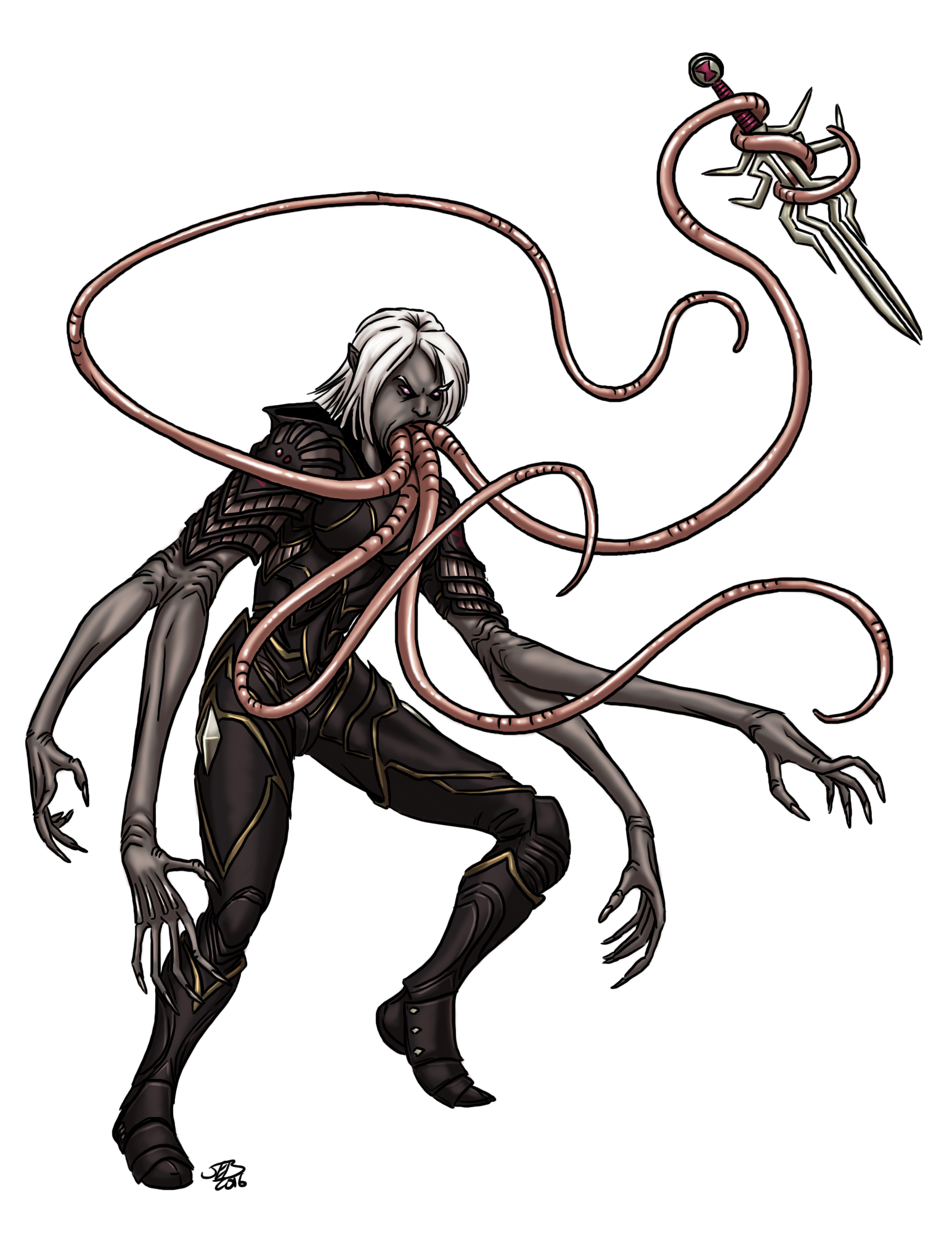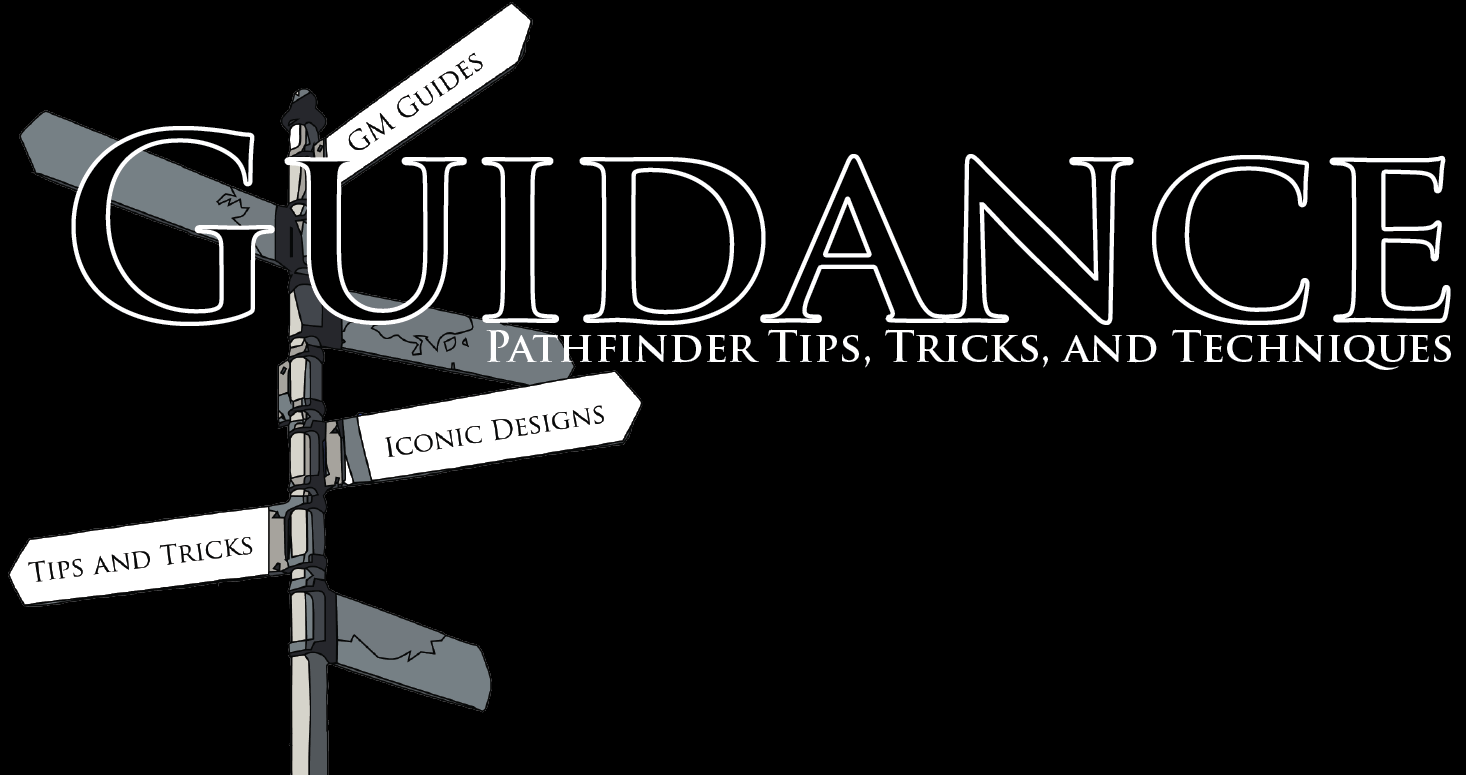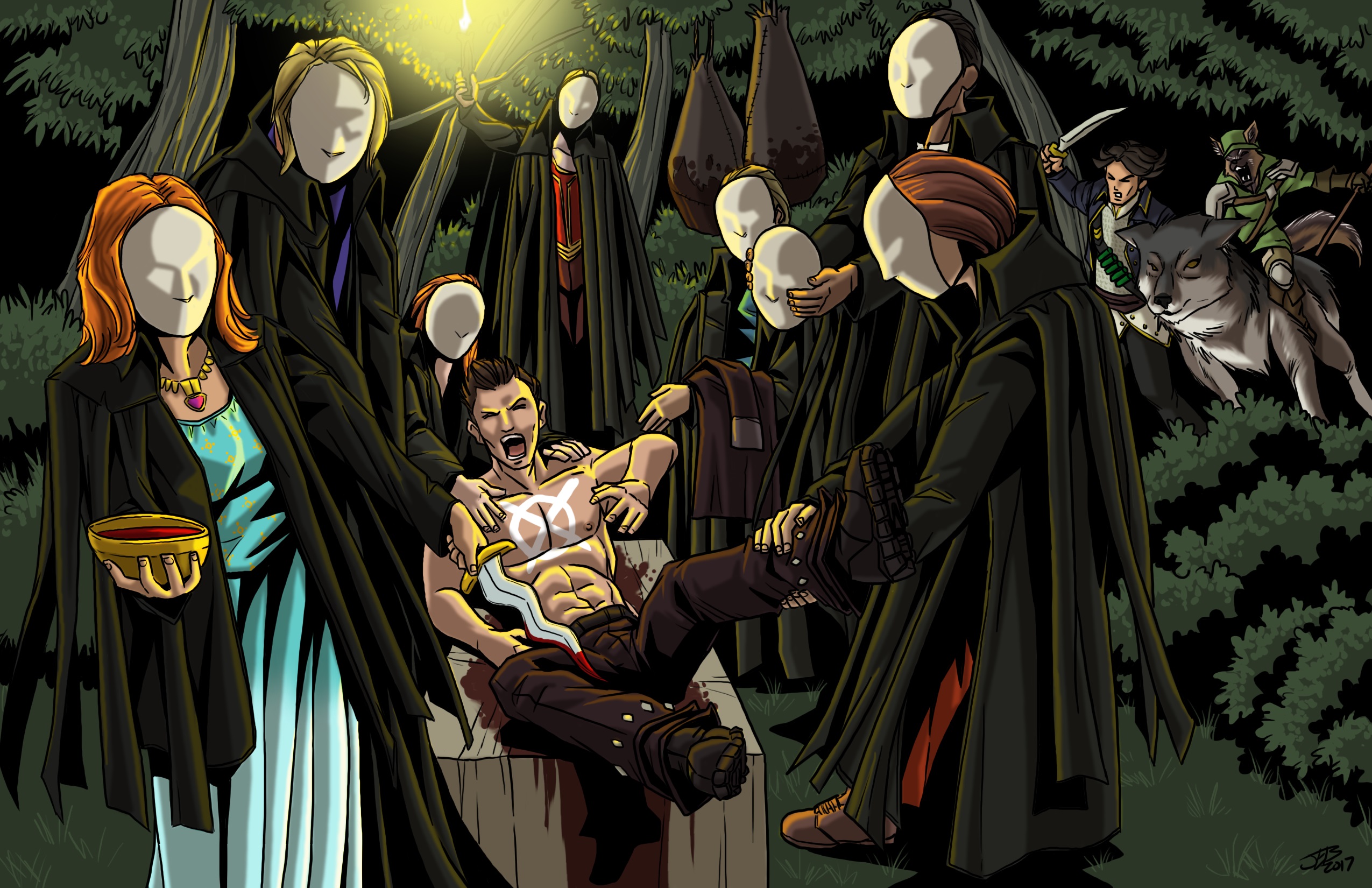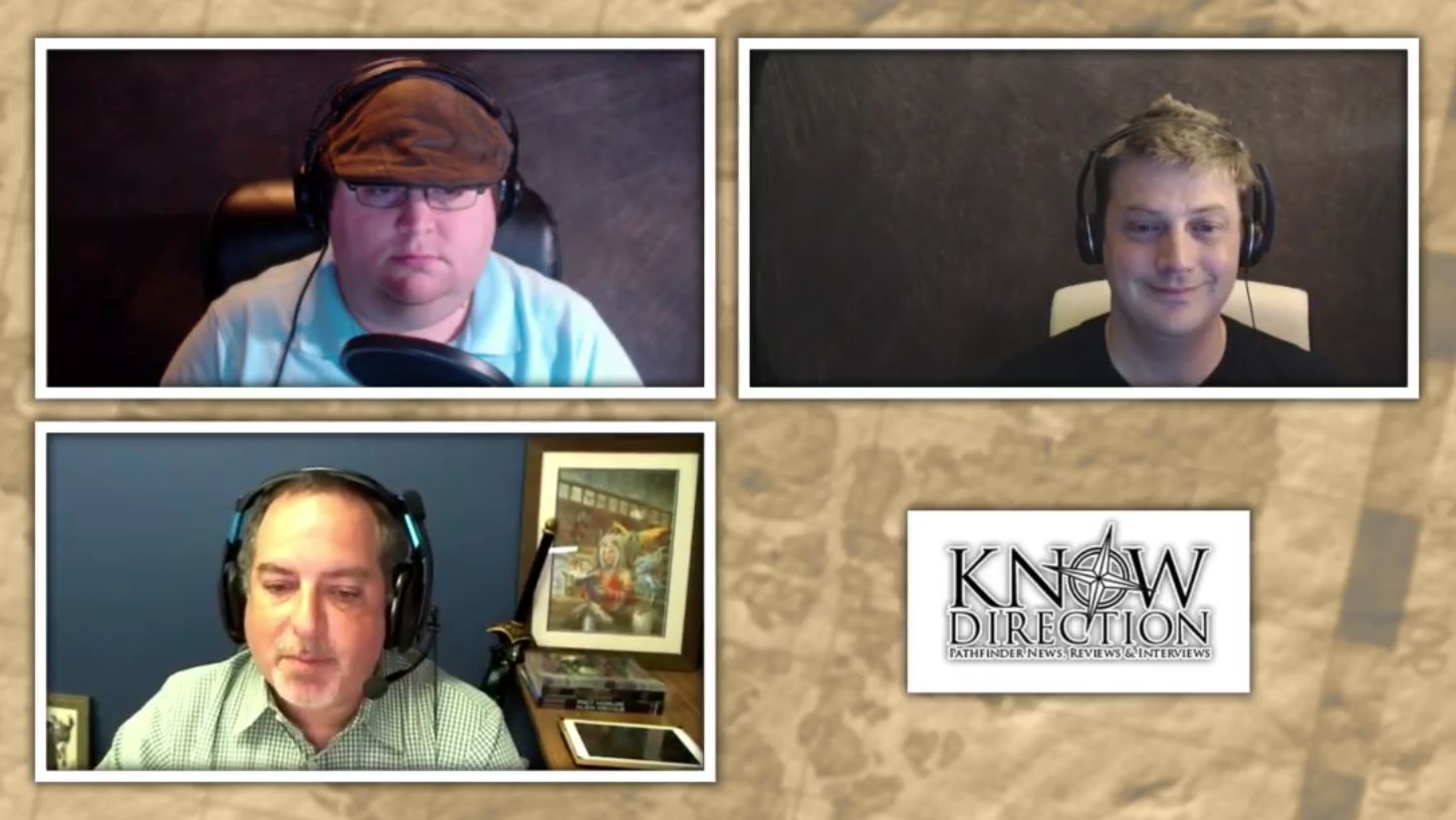Welcome to Guidance! As many of you know, I’m currently running James Ballod of KDN’s Code Switch Blog (as well as a few of our local gamers) through the Strange Aeons adventure path. I absolutely ADORE Strange Aeons for a number of reasons—it’s got the best story in all of Pathfinder, its heavily driven by character arcs for its NPCs, and it does a good job of having a mix of tough fights and really challenging fights. I’m also a huge fan of Lovecraft’s flavor of cosmic horror (though not so much his racism), and get a great kick out of otherworldly monsters.
Now in my experience, for most GMs crafting a horror experience is a lot like following a cooking recipe that your grandmother wrote. Yeah, you know it’ll make something amazingly delicious, but all of the advice you got uses imprecise measurements and general tidbits of lore rather than actual steps. “Put a pinch of salt when the stew’s ready,” sounds a lot like, “Make your atmosphere creepy,” doesn’t it? Now, if we’re being honest, talking about running a horror game is NOT something I was originally going to devote to a blog. After all, every year at PaizoCon the Paizo Staffers put out an amazing podcast that gives great tips to running a horror game. Go listen to them! However, what got me to write this blog a new-ish PFS scenario written by my friend and colleague Isabelle Lee called Oath of the Overwatched. Now, let me tell you this one teeny spoiler—Oath of the Overwatched is basically a Cthulhu-lite scenario. Play it if you want the experience, but know that I’m not going to spoil it further here.
With that out of the way, Oath of the Overwatched is 100% a game that works well as a horror game, but interestingly enough the designers in this one don’t really give any advice for running it as such. (In context, another scenario called Reaping What We Sow does give advice for running it as a Horror Game; likely because Horror Adventures came out around the same time.) It always struck me interesting that Oath of the Overwatched doesn’t call out how to run it as a horror game, given its subject matter. When I spoke about it to one of the PFS locals, they pointed out that even running the game as written with the horror emphasis, Reaping What We Sow doesn’t really hit the horror vibe. So what did I do? I decided to test my Strange Aeons horror strategies by running Oath of the Overwatched at a local convention for some friendly players (including our friend Robyn, my former Reign of Winter GM and current Dead Suns compatriot who had actually run Oath of the Overwatched).
Spoiler Alert—I REALLY creeped my players out.
How did I do it? Well, that’s the focus on today’s article! Players beware, you’re in for a scare!
Understanding the OP Atmosphere
Whenever you listen to one of those “How to Run Horror” seminars, one of the first things they always tell you is, “Make sure you use spooky music and set the atmosphere to be extra spooky.” I am going to preface by telling you that spooky atmospheres are NOT a good idea for trying to scare people who may not be bought into the horror experience. It is very, very easy to ruin spooky atmosphere with an inopportune joke or casual conversation—people have TONS of defenses against music, as effective as it may be. Additionally, when you’re running Organized Play, you’re likely in a venue whose atmosphere you have no control over, like a convention hall or a store. Music is easy to talk over and even Syrinscape doesn’t work in places with no internet connection and loud noise (see: GenCon).
Use this stuff in the comfort of your own home or in a private setting, but don’t think that this is going to work for OP. No, there are WAY more effective ways to scare your players.
Know Your ABCs
When you’re trying to scare your players, you need to remember that miniatures are not inherently scary, neither is art in a monster manual. Instead, your most powerful tool for scaring your players is your words. More importantly, its how and where you apply your words—especially your descriptions—that are your biggest weapon in the fight for fright. When you’re picking words, remember your ABCs: Audio/Visual, Body, and Circumstanial!
Audio/Visual
Remember how I said that music wasn’t always scary? Its not, but what IS scary is descriptions of audible stimuli—things your characters hear. If you want to scare your PCs, pick these words CAREFULLY and make sure to keep them varied. Remember, ultimately things your players can process are immediately less scary simply BECAUSE your players are processing them in an environment they consider safe. For example, playing a sound clip of a wolf howling is not scary because its recorded, static and unchanging. But if you tell your player, “Your character hears a canine howl in the distance whose hungry, bloodcurdling screech raises the hairs on the back of your neck and rolls beads of sweat down your shoulders,” that is intrinsically less scary because you are giving your players a description, forcing their brains to take the information you’ve given them and process it. And often times, when you use words that have a scary connotation you’ll trick your players’ brains into processing that information in a way that is uniquely scary to them.
Author’s Anecdote: In Strange Aeons, there’s an event where your players go to a party where everyone is dancing around while something is reaching down with webs and hoisting party goes up into the shadowy rafters. The partygoes refuse to acknowledge it for fear of offending the host, but this is an opportunity that is ripe with horror. Knowing this, I described the scene as something like this:
PC: “Okay, we ask her where the prince is.”
GM: “She lifts her nose at you indignantly as she begins to speak, but then suddenly a tendril of white, sticky material falls from the ceiling and attaches itself to the woman’s neck. Before she can turn around to see what’s happened, she’s hoisted up into the air and begins screaming for help. Curiously, everyone around you seems to turn away from the spectacle even as she’s raised 30 feet into the air towards shadowy rafters above.”
PC: “Ah! I cast break on the webbing! I can do that, its an object, right?”
GM: “Yeah, it is. The webbing breaks and she plummets 30 feet towards the ground….”
PC: “I move to catch her!”
GM: “But before she falls so much as an inch, two additional tendrils shoot out from the shadows, grab her by each arm, and hoist her into the shadows in a blink of an eye.”
PC: “Wha?! I can’t do anything about it?”
GM: “You can try to find your way up there, but you hear a loud wail in a feminine voice coming from above, followed by a sound that can only be described as bears ferociously mauling a thin wooden tree. You hear wet ripping and snapping noises before the screams fall silent.”
PC: *says nothing, face agap in horror*

Doing terrible stuff to the PCs’ bodies is one of the best ways to scare them.
Body
Back to description words, the absolute best way to scare the pants off of your PCs is to describe something happening to their bodies. If someone describes something icky happening to your flesh suit, as in, your PERSONAL flesh suit, it is psychologically difficult to not imagine the thing being described. This needs to be something more then a simple, “You lose your arm,” or “You have a deep cut.” You need to really sell the details—that’s where the devil is.
Author’s Anecdote: In Oath of the Overwatch, my players had to fight these horrible monsters with a nasty poison. This was their first fight into what I would consider the “Lovecraftian reveal” of the scenario, and I wanted to drill the horror home (up until this point, I had been very horror-light). So when they fought the monsters, this happened.
GM: “Okay, so the attack hits. Roll me a Fortitude save against poison.”
PC: “I roll a 24!”
GM: *Checks notes. A 24 is sufficient to succeed* “Okay. Where the creature bites you, a dark, blue liquid pulses through your veins. You can see the ichor pushing its way through your arm slowly through your skin, up towards your chest. Wherever the ichor touches, your skin begins to gray and eventually turn white. After a few seconds, the ichor stops spreading and although the color doesn’t revert to normal, your arm doesn’t feel any worse then its fit after taking similar puncture wounds.”
PC: *Face is twisted into an expression halfway between disgusted and horrified as she clutches her nondominant arm*
Circumstanial
Its important when you’re trying to portray horror that you do it circumstantially—meaning when the stars are right. If you try to be horrifying every minute of every game, you’ll fail. Your players will get fatigued, they’ll start telling jokes to try and rationalize what you’re saying to them, and essentially horror will become the new “normal,” so you’ll have to amp up your horror game even more to phase them (which is NOT an easy task). So instead, you need to lull your players into a false sense of security to do horror well. You CANNOT give them any preparation for the horror you’re about to throw at them. This means you need times of “normal” behavior. Times where you’re silly, serious, heroic, et al. If you try to be horrifying all the time, you end up being horrifying none of the time.
Along these same lines, one of the best ways to BE horrifying is to make your players think that you don’t realize how horrifying the situation is. You need to act like everything is completely normal. Blue ichor coursing through the veins is stated as something that just seems obvious, rather than creepy. The reason this works is the reason why so many people sit down for a horror movie and aren’t scared. When you pop a scary movie into your DVD player or order it on Netflix, you’re mentally preparing yourself for the horror. You’re watching the movie set up the characters while thinking to yourself, “Okay, based on their personalities who is this movie gonna kill?” It’s a survival mechanism to deal with potential psychological trauma. But if you want to scare your players, you need to hit them with horror before those mechanisms can come up, and retreat them just as quickly. You gotta float like a witch and sting like a killer clown from outerspace.
Author’s Anecdote: Oath of the Overwatch takes place entirely within a magical library of sorts, but I wanted to catch them with their pants down on the horror stuff so I could inflict horror upon their poor, feeble minds. To do this, I described the library fairly unremarkably, relying on box text and the flip map I bought to explain information to the PCs. However, I wanted to give them clues as to what’s coming. A jump scare before drowning them in the horror, if you would. So this happened.
GM: “Okay, you failed a skill check. The entire library seems to rattle and shake ominously, as if an earthquake was happening. Then, suddenly, a small tear large enough to stick your head through appears in the air in front of you, leading out into an inky black starscape twinkling with motes of light. Suddenly, an eye the size of your torso appears in the rip, slowly blinks once as it recognizes you, and simply floats away followed by a trail of bitch-blackness that lasts several seconds before the starscape reappears behind it.”
PC: *The player who failed the skill check* “What the #### was that?!”
GM: “While this happens, all the librarians in the library continue putting away the books without so much as stumbling. The librarian you spoke to has a furrowed brow and appears to be muttering complaints about the library’s organizational system as he reaches up on his toes to put the book away.”
PC: *More cursing*
In Summary
The best advice I can give to you regarding running horror games is, “Evoke your player’s brains using your descriptions.” The more energy you put into describing something scary, the scarier it will become. This has the double-edged sword of making sure not to try too hard. In my experience, describing scary stuff in a nonchalant tone that seems almost dismissive of what’s happening works best, as if you’re talking about a footnote or a similarly insignificant bit of information. Within this disconnect, your players start saying, “How can you be fine with this? What’s happening is TERRIFYING!”
To close out this article, I want to give a follow-up on the third anecdote—the one with the eye. After I read my bit, the player asked me if he could stick his head into the rift to see what was looking at him. I told him yes. He did it, and I asked him for a DC 10 Constitution check. He passed, so I said:
GM: “Okay. You successfully hold your breath.”
PC: “What?!”
GM: “Yeah, you stick your head out there and there’s no air. What do you do?”
PC: “I pull my head back in.”
GM: “Oh. Okay, you don’t need to make Constitution checks anymore.”
PC: “That’s it?”
GM: “A huh.”
PC: “If that goes out to space, why is everything not being sucked in towards it.”
GM: “I don’t know.”
PC: “That’s how airlock breaches work, Alex! It all goes and tries to fill the void but it can’t, so the stuff just gets sucked out.”
GM: “Yeah, you’re right. It’s weird that there’s no vacuum though, isn’t there? Anyway, are you ready to keep looking for books?”
PC: *Unleashes a desperate wail of angst*
What a fun adventure! Speaking of fun adventures, Monica Marlowe (author of KDN’s Inspire Confidence blog) recently got into a fight with an internet troll about paladin code of conducts. After yelling into the void for a bit, I’ve decided that I want to talk about what makes a good paladin code of conduct next week, so I’m going to do that. But not next week. Next week I’m going to be taking a common Starfinder Design request for Iconic Design by building a melee technomancer. Will it work? I dunno, let’s hope so! But until next time, I’m Alex Augunas and I’m always here for YOU when you need a little bit of Guidance. Take care!

Alexander “Alex” Augunas has been playing roleplaying games since 2007, which isn’t nearly as long as 90% of his colleagues. Alexander is an active freelancer for the Pathfinder Roleplaying Game and is best known as the author of the Pact Magic Unbound series by Radiance House. Alex is the owner of Everyman Gaming, LLC and is often stylized as the Everyman Gamer in honor of Guidance’s original home. Alex also cohosts the Private Sanctuary Podcast, along with fellow blogger Anthony Li, and you can follow their exploits on Facebook in the 3.5 Private Sanctuary Group, or on Alex’s Twitter, @AlJAug.
If you like the art for this blog, contact Jacob Blackmon at commissionprodigyduck@gmail.com! He’s really fast, great at PC / party / boss villain pictures, and frequently has commission slots open. Immortalize your PCs today!







Pardon my ignorance, but what does OP mean in this context?